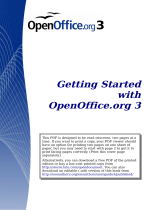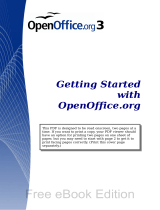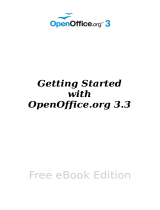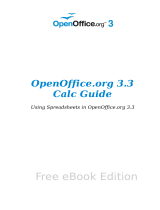Page is loading ...

Writer Guide
Word Processing with OpenOffice.org
This PDF is designed to be read onscreen, two pages at a
time. If you want to print a copy, your PDF viewer should
have an option for printing two pages on one sheet of
paper, but you may need to start with page 2 to get it to
print facing pages correctly. (Print this cover page
separately.)
Second edition
March 2010
Updated for V3.2
Free eBook Edition

Copyright
This document is Copyright © 2005–2010 by its contributors as listed
in the section titled Authors. You may distribute it and/or modify it
under the terms of either the GNU General Public License, version 3 or
later, or the Creative Commons Attribution License, version 3.0 or
later. All trademarks within this guide belong to their legitimate
owners.
Authors
Jean Hollis Weber Michele Zarri
Magnus Adielsson Agnes Belzunce
Ken Byars Bruce Byfield
Daniel Carrera Dick Detwiler
Laurent Duperval Martin Fox
Katharina Greif Tara Hess
Peter Hillier-Brook Lou Iorio
John Kane Stefan A. Keel
Michael Kotsarinis Sigrid Kronenberger
Peter Kupfer Ian Laurenson
Alan Madden Paul Miller
Vincenzo Ponzi Scott Rhoades
Carol Roberts Iain Roberts
Gary Schnabl Robert Scott
Janet M. Swisher Barbara M. Tobias
Catherine Waterman Bob Wickham
Claire Wood Linda Worthington
Feedback
Please direct any comments or suggestions about this document to:
Publication date and software version
Second edition. Published 25 March 2010. Based on OpenOffice.org
3.2.
You can download
an editable version of this document from
http://oooauthors.org/english/userguide3/published/
Free eBook Edition

Contents
Chapter 1
Introducing Writer...................................................................10
What is Writer?.................................................................................11
Starting Writer.................................................................................. 11
The Writer interface..........................................................................15
Changing document views................................................................23
Using the Navigator..........................................................................23
Starting a new document..................................................................28
Opening an existing document..........................................................30
Saving a document............................................................................ 31
Getting help......................................................................................33
Undoing and redoing changes..........................................................34
Closing a document..........................................................................34
Closing Writer...................................................................................35
Chapter 2
Setting up Writer......................................................................36
Choosing options that affect all of OOo............................................37
Choosing options for loading and saving documents........................50
Choosing options for Writer..............................................................56
Choosing options for HTML documents............................................66
Choosing language settings..............................................................66
Controlling Writer’s AutoCorrect functions......................................69
Chapter 3
Working with Text.....................................................................70
Introduction......................................................................................71
Selecting text....................................................................................71
Cutting, copying, and pasting text....................................................73
Finding and replacing text................................................................74
Inserting special characters..............................................................78
Formatting paragraphs.....................................................................80
Formatting characters......................................................................84
OpenOffice.org 3.x Writer Guide 3
Free eBook Edition

Autoformatting..................................................................................84
Creating numbered or bulleted lists.................................................86
Using footnotes and endnotes...........................................................89
Checking spelling and grammar.......................................................91
Using built-in language tools............................................................93
Using the thesaurus..........................................................................95
Hyphenating words...........................................................................95
Using AutoCorrect............................................................................98
Using word completion.....................................................................99
Using AutoText................................................................................100
Line numbering...............................................................................100
Tracking changes to a document....................................................101
Adding other comments..................................................................105
Linking to another part of a document...........................................107
Switching between insert and overwrite mode...............................112
Counting the words in a selection...................................................112
Chapter 4
Formatting Pages.....................................................................113
Introduction....................................................................................114
Choosing a layout method...............................................................114
Setting up basic page layout using styles.......................................116
Changing page margins..................................................................121
Using columns to define the page layout........................................122
Using frames for page layout..........................................................126
Using tables for page layout...........................................................133
Using sections for page layout........................................................136
Updating links................................................................................. 144
Creating headers and footers..........................................................146
Numbering pages............................................................................150
Defining borders and backgrounds.................................................161
4 OpenOffice.org 3.x Writer Guide
Free eBook Edition

Chapter 5
Printing, Exporting, Faxing, and E-Mailing...........................165
Introduction....................................................................................166
Quick printing.................................................................................166
Controlling printing........................................................................166
Printing a brochure.........................................................................170
Printing envelopes..........................................................................171
Printing labels.................................................................................174
Sending a fax..................................................................................176
Exporting to PDF............................................................................176
Exporting to XHTML.......................................................................183
E-mailing Writer documents...........................................................183
Digital signing of documents..........................................................187
Chapter 6
Introduction to Styles.............................................................188
What are styles?..............................................................................189
The Styles and Formatting window.................................................190
Applying styles................................................................................195
Modifying styles..............................................................................203
Creating custom paragraph styles: examples.................................208
Copying and moving styles.............................................................212
Deleting styles................................................................................214
Assigning styles to shortcut keys....................................................215
Defining a hierarchy of headings....................................................215
Chapter 7
Working with Styles..................................................................224
Introduction....................................................................................225
Creating custom (new) styles..........................................................225
Working with paragraph styles.......................................................229
Working with conditional paragraph styles.....................................241
Working with character styles........................................................243
Working with frame styles..............................................................246
Working with page styles................................................................249
OpenOffice.org 3.x Writer Guide 5
Free eBook Edition

Working with list styles...................................................................259
Chapter 8
Working with Graphics...........................................................268
Graphics (images) in Writer............................................................269
Creating and editing images...........................................................269
Adding images to a document.........................................................271
Modifying an image........................................................................276
Using Writer’s drawing tools..........................................................283
Positioning graphics within the text................................................286
Adding captions to graphics............................................................296
Creating an image map...................................................................300
Adding an image to the Gallery.......................................................302
Chapter 9
Working with Tables...............................................................304
Introduction....................................................................................305
Creating a table..............................................................................305
Formatting the table layout............................................................309
Formatting the table text................................................................319
Data entry and manipulation in tables............................................322
Additional table operations.............................................................325
The Table menu and toolbar...........................................................332
Chapter 10
Working with Templates.........................................................335
Introduction....................................................................................336
Using a template to create a document..........................................336
Creating a template........................................................................337
Editing a template........................................................................... 339
Adding templates with Extension Manager....................................341
Setting a default template..............................................................342
Associating a document with a different template..........................343
Organizing templates......................................................................345
6 OpenOffice.org 3.x Writer Guide
Free eBook Edition

Chapter 11
Using Mail Merge...................................................................348
What is mail merge?.......................................................................349
Creating the data source................................................................349
Registering a data source...............................................................350
Creating a form letter.....................................................................353
Printing mailing labels....................................................................358
Printing envelopes..........................................................................363
Using the Mail Merge Wizard to create a form letter.....................368
Chapter 12
Tables of Contents, Indexes, and Bibliographies...................380
Introduction....................................................................................381
Tables of contents...........................................................................381
Alphabetic indexes..........................................................................393
Other types of indexes....................................................................403
Bibliographies................................................................................. 405
Tools for working with bibliographies.............................................417
Chapter 13
Working with Master Documents...........................................418
Why use a master document?.........................................................419
Styles and master documents.........................................................419
Using the Navigator........................................................................420
Creating a master document...........................................................421
Recommended method for creating master documents..................423
Editing a master document.............................................................432
Cross-referencing between subdocuments.....................................433
Creating one file from a master document and its subdocuments..437
Problem solving..............................................................................439
Chapter 14
Working with Fields...............................................................444
Introduction to fields......................................................................445
Quick and easy field entry..............................................................445
Using document properties to hold information that changes........446
OpenOffice.org 3.x Writer Guide 7
Free eBook Edition

Using other fields to hold information that changes.......................447
Using AutoText to insert often-used fields......................................449
Defining your own numbering sequences.......................................450
Using automatic cross-references...................................................452
Using fields in headers and footers.................................................456
Using fields instead of outline numbering for appendix numbering
........................................................................................................ 458
Tricks for working with fields.........................................................459
Developing conditional content.......................................................460
Using placeholder fields.................................................................468
Using input fields and input lists....................................................469
Chapter 15
Using Forms in Writer............................................................473
Introduction to forms......................................................................474
When to use forms..........................................................................474
Creating a simple form...................................................................475
Form controls reference.................................................................478
Example: a simple form..................................................................484
Accessing data sources...................................................................490
Advanced form customization.........................................................497
XForms............................................................................................500
Chapter 16
Math Objects..........................................................................501
What is Math?.................................................................................502
Chapter 17
Customizing Writer................................................................503
Introduction....................................................................................504
Customizing menu content.............................................................504
Customizing toolbars......................................................................508
Assigning shortcut keys..................................................................512
Assigning macros to events.............................................................517
Adding functionality with extensions..............................................518
8 OpenOffice.org 3.x Writer Guide
Free eBook Edition

Appendix A
Keyboard Shortcuts................................................................521
Introduction....................................................................................522
Function keys for Writer.................................................................523
Shortcut keys for Writer.................................................................524
Shortcut keys for tables in Writer...................................................526
Shortcut keys for paragraphs and heading levels...........................527
Shortcut keys for moving and resizing frames, graphics and objects
........................................................................................................ 528
Index.........................................................................................529
OpenOffice.org 3.x Writer Guide 9
Free eBook Edition

Chapter 1
Introducing Writer
Free eBook Edition

What is Writer?
Writer is the word processor component of OpenOffice.org (OOo). In
addition to the usual features of a word processor (spelling check,
thesaurus, hyphenation, autocorrect, find and replace, automatic
generation of tables of contents and indexes, mail merge, and others),
Writer provides these important features:
• Templates and styles
• Page-layout methods, including frames, columns, and tables
• Embedding or linking of graphics, spreadsheets, and other
objects
• Built-in drawing tools
• Master documents—to group a collection of documents into a
single document
• Change tracking during revisions
• Database integration, including a bibliography database
• Export to PDF, including bookmarks
• And many more
Styles are central to using Writer. Using styles, you can easily format
your document consistently and change the format with minimal effort.
A style is a named set of formatting options. Writer defines several
types of styles, for different types of elements: characters, paragraphs,
pages, frames, and lists. Often, you are using styles whether you
realize it or not. The use of styles is described in more detail in
Chapter 6 (Introduction to Styles) and Chapter 7 (Working with Styles).
The other features of Writer listed above are also covered in detail in
other chapters of this guide.
Starting Writer
If you are reading this document in OpenOffice.org, you already know
how to start Writer. However, if this is a printed version or a PDF
version, you may not know how to start Writer. So let’s look at three
ways to do that:
• From the system menu
• From an existing document
• From the command line
Chapter 1 Introducing Writer 11
Free eBook Edition

Starting from the system menu
The most common way to start Writer is by using the system menu,
the standard menu from which most applications are started. On
Windows, it is called the Start menu. On GNOME, it is called the
Applications menu. On KDE, it is identified by the KDE logo. On Mac
OS X, it is the Applications menu.
When OpenOffice.org was installed on your computer, in most cases a
menu entry for each component was added to your system menu. (If
you are using a Mac, see note below.) The exact name and location of
these menu entries depends on the operating system and graphical
environment.
Note for Mac users
You should see the OpenOffice.org icon in the Applications folder.
When you double-click this icon, a text document opens in Writer. To
open the other components (Draw, Calc, Impress, Base), go to the File
menu of the Writer window and select the component you want.
OOo does not automatically put a shortcut icon on the desktop, but you
can add one if you wish. If you don’t know how to add shortcut icons
for launching programs, please consult the help for your operating
system.
Starting from an existing document
All Writer documents are associated with the Writer application. This
means that you can start OpenOffice.org automatically, simply by
double-clicking a Writer document in a file manager such as Windows
Explorer.
You can spot an OpenOffice.org Writer document by its icon: .
Note for Windows users
If you have associated Microsoft Office file types with OOo, then when
you double-click on a *.doc (Word) file, it opens in OOo Writer.
If you did not associate the file types, then when you double-click on a
Microsoft Word document, it opens in Microsoft Word (if Word is
installed on your computer).
You can use another method to open *.doc files in OOo and save in the
*.doc format from OOo. See “Opening an existing document” on page
30 for more information.
12 OpenOffice.org 3.x Writer Guide
Free eBook Edition

Using the Quickstarter under Windows
The Quickstarter is an icon that is placed in the Windows system tray
during system startup. It indicates that OpenOffice.org has been
loaded and is ready to use. (The Quickstarter loads library *.DLL files
required by OOo, thus shortening the startup time for OOo components
by about half.) If the Quickstarter is disabled, see “Reactivating the
Quickstarter” on page 14 if you want to enable it.
Using the Quickstarter icon
Right-click the Quickstarter icon in the system tray to open a pop-up
menu from which you can open a new document, open the Templates
and Documents dialog box, or choose an existing document to open.
You can also double-click the Quickstarter icon to display the
Templates and Documents dialog box.
Figure 1: Quickstarter pop-up menu
Disabling the Quickstarter
To close the Quickstarter, right-click on the icon in the system tray and
then click Exit Quickstarter on the pop-up menu. The next time the
computer is restarted, the Quickstarter will be loaded again.
To prevent OpenOffice.org from loading during system startup,
deselect the Load OpenOffice.org During System Start-Up item on
the pop-up menu. You might want to do this if your computer has
insufficient memory, for example.
Chapter 1 Introducing Writer 13
Free eBook Edition

Reactivating the Quickstarter
If the Quickstarter has been disabled, you can reactivate it by selecting
the Load OpenOffice.org during system start-up option in Tools >
Options > OpenOffice.org > Memory.
Using the Quickstarter under Linux
Some installations of OpenOffice.org under Linux have a Quickstarter
that looks and acts like the one described above for Windows (the
option on the Memory page is labeled Enable systray quickstarter).
Preloading OOo under Linux/KDE
In Linux/KDE, you can use KDocker to have OOo loaded and ready for
use at startup. KDocker is not part of OOo; it is a generic “systray app
docker” that is helpful if you open OOo often.
Starting from the command line
You may want to start Writer from the command line (using the
keyboard instead of the mouse). Why? Well, by using the command
line, you have more control over what happens when Writer is started.
For example, using the command line, you can tell Writer to load a
document and print it immediately, or to start without showing the
splash screen.
Note
Most users will never need to do this.
There is more than one way to start Writer from the command line,
depending on whether you have installed a customized version or the
standard download from the OOo web site.
If you installed using the download on the OOo web site, you can start
Writer by typing at the command line:
soffice -writer
or
swriter
Writer will start and create a new document.
To see a list of options you can use when starting Writer at the
command line, type:
soffice -?
Below is a list of some of the more popular options.
14 OpenOffice.org 3.x Writer Guide
Free eBook Edition

Option Description
-help
Get a complete list of options.
-nologo
Do not show the startup screen.
-show <odp-file>
Start presentation immediately.
-view <documents ...>
Open documents in viewer (read-only) mode.
-minimized
Start OOo minimized.
-norestore
Suppress restart/restore after fatal errors.
-invisible
No startup screen, no default document and
no UI. This is useful for third-party
applications that use functionality provided
by OOo.
If you have a customized version of OOo (such as the one provided by
Linux Mandrake or Gentoo), you can start Writer by typing at the
command line:
oowriter
Note
Although the command syntax differs, the effect is identical: it
starts OOo with an empty Writer document.
The Writer interface
The main Writer workspace is shown in Figure 2.
Figure 2: The main Writer workspace in Print Layout view
Chapter 1 Introducing Writer 15
Free eBook Edition

Menus
The Menu bar is located across the top of the Writer window, just
below the Title bar. When you choose one of the menus listed below, a
submenu drops down to show commands.
• File contains commands that apply to the entire document such
as Open..., Save, and Export as PDF....
• Edit contains commands for editing the document such as Undo:
xxx (where xxx is the command to undo) and Find &
Replace.... It also contains commands to cut, copy, and paste
selected parts of your document.
• View contains commands for controlling the display of the
document such as Zoom... and Web Layout.
• Insert contains commands for inserting elements into your
document such as headers, footers, and pictures.
• Format contains commands for formatting the layout of your
document, such as Styles and Formatting, Paragraph, and
Bullets and Numbering.
• Table shows all commands to insert and edit a table in a text
document.
• Tools contains functions such as Spelling and Grammar,
Customize..., and Options....
• Window contains commands for the display window.
• Help contains links to the OpenOffice.org Help file, What’s This?,
and information about the program. See “Getting help” on page
33.
Toolbars
Writer has several types of toolbars: docked, floating, and tear-off.
Docked toolbars can be moved to different locations or made to float,
and floating toolbars can be docked.
The top docked toolbar (default position) is called the Standard
toolbar. The Standard toolbar is consistent across the OpenOffice.org
applications (Writer, Calc, Draw, Impress, Base).
The second toolbar across the top (default location) is the Formatting
toolbar. It is a context-sensitive bar that shows the relevant tools in
response to the cursor’s current position or selection. For example,
when the cursor is on a graphic, the Formatting bar provides tools for
formatting graphics; when the cursor is in text, the tools are for
formatting text.
16 OpenOffice.org 3.x Writer Guide
Free eBook Edition

Displaying or hiding toolbars
To display or hide toolbars, choose View > Toolbars, then click on the
name of a toolbar in the list. An active toolbar shows a check mark
beside its name. Tear-off toolbars are not listed in the View menu.
Submenus and tear-off toolbars
Toolbar icons with a small triangle to the right will display submenus,
tear-off toolbars, and other ways of selecting things, depending on the
icon. Figure 3 shows a tear-off toolbar from the Drawing toolbar.
Tear-off toolbars can be floating or docked along an edge of the screen
or in one of the existing toolbar areas. To move a floating tear-off
toolbar, drag it by the title bar. See “Moving toolbars” below.
Figure 3: Example of a tear-off toolbar
Moving toolbars
To move a docked toolbar, place the mouse pointer over the toolbar
handle, hold down the left mouse button, drag the toolbar to the new
location, and then release the mouse button (Figure 4).
To move a floating toolbar, click on its title bar and drag it to a new
location (Figure 5).
Chapter 1 Introducing Writer 17
Click here and drag Toolbar tears off and floats
Free eBook Edition

Figure 4: Moving a docked toolbar
Figure 5: Moving a floating toolbar
Floating toolbars
Writer includes several additional context-sensitive toolbars, whose
defaults appear as floating toolbars in response to the cursor’s current
position or selection. For example, when the cursor is in a table, a
floating Table toolbar appears, and when the cursor is in a numbered
or bullet list, the Bullets and Numbering toolbar appears. You can dock
these toolbars to the top, bottom, or side of the window, if you wish
(see “Moving toolbars” on page 17).
Docking/floating windows and toolbars
Toolbars and some windows, such as the Navigator and the Styles and
Formatting window, are dockable. You can move, resize, or dock them
to an edge.
18 OpenOffice.org 3.x Writer Guide
Free eBook Edition

To dock a window, do one of the
following:
• Click on the title bar of the
floating window and drag it to
the side until you see the outline
of a box appear in the main
window (see Figure 6) and then
release the window. This method
depends on your system’s
window manager settings, so it
may not work for you.
• Hold down the Control key and
double-click on a vacant part of
the floating window to dock it in
its last position. If that does not
work, try double-clicking
without using the Control key.
To undock a window, hold down the
Control key and double-click on a
vacant part of the docked window.
Figure 6: Docking a window
Note
The Styles and Formatting window can also be docked or
undocked by using Control+double-click on the gray area next to
the icons at the top of the window.
Customizing toolbars
You can customize toolbars in several ways, including choosing which
icons are visible and locking the position of a docked toolbar. You can
also add icons and create new toolbars, as described in Appendix B.
To access a toolbar’s customization options, use the down-arrow at the
end of the toolbar or on its title bar (see Figure 7).
Figure 7: Customizing toolbars
To show or hide icons defined for the selected toolbar, choose Visible
Buttons from the drop-down menu. Visible icons have a checkmark
next to them. Click on icons to select or deselect them.
Chapter 1 Introducing Writer 19
Free eBook Edition

Right-click (context) menus
You can quickly access many menu functions by right-clicking on a
paragraph, graphic, or other object. A context menu will pop up. Often
the context menu is the fastest and easiest way to reach a function. If
you’re not sure where in the menus or toolbars a function is located,
you can often find it by right-clicking.
Rulers
To show or hide rulers, choose View > Ruler. To enable the vertical
ruler, choose Tools > Options > OpenOffice.org Writer > View and
select Vertical ruler.
Figure 8. Turning on the vertical ruler
Status bar
The Writer status bar provides information about the document and
convenient ways to quickly change some document features. From left
to right, the fields are as follows.
Figure 9: Left end of status bar
Page number
Shows the current page number, the sequence number of the
current page (if different), and the total number of pages in the
document. For example, if you restarted page numbering at 1 on the
third page, its page number is 1 and its sequence number is 3.
20 OpenOffice.org 3.x Writer Guide
Free eBook Edition
/











![SuseLinux Professional 9.2 Upgrade [Strong Encryption 128 Bit]](http://vs1.manuzoid.com/store/data/000336272_2-8918b86fe5596dedffb3db1221048e46-160x210.png)